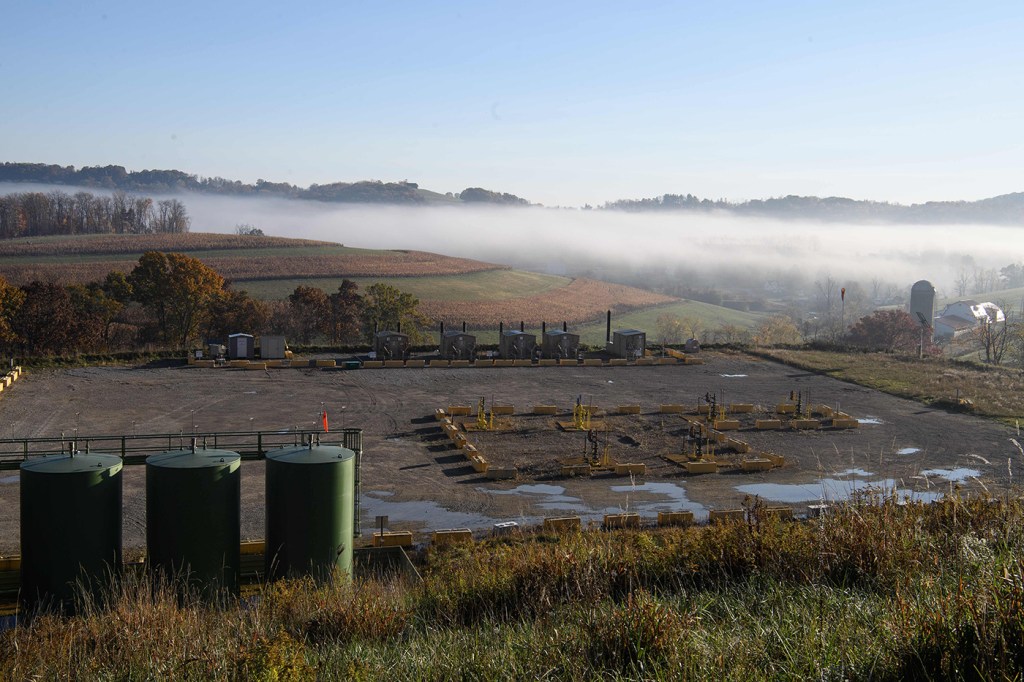What amount of dangerous chemicals used in fracking go unreported? More than scientists imagined

A group of scientists, led by a Northeastern environmental justice lab, analyzed available data on chemicals used in fracking and arrived at some staggering conclusions.
Almost 18 million people, or 5.4% of the U.S. population, live within a mile of an oil or gas well. About one-third are non-white and from ethnic backgrounds. And older individuals, young children and people with low incomes are among the most vulnerable.
The purpose of the research was to highlight the lack of mandatory disclosure in federal legislation.
“We really wanted to draw attention to the fact that the environmental and, therefore, the environmental justice impacts of fracking aren’t being properly assessed because of the lack of monitoring and [existing] exemptions,” says Vivian Underhill, a postdoctoral research fellow in the Wylie Environmental Data Justice Lab at Northeastern and the lead author of the study.
Hydraulic fracturing, or fracking, is a process that involves injecting water, sand and chemicals under high pressure into a bedrock formation through a well. This creates new fractures in the rock or increases the size and connectivity of existing fractures to free up oil or gas reserves.
The study quantified the number of disclosures and the total mass of chemicals reported between 2014 and 2021. The researchers found that chemicals that were reported amounted to 2.82 million pounds, or almost twice as much as the weight of the Washington monument. But the real surprise was that they constitute only 4% of the chemicals reported in proprietary formulas (more than 7.2 billion pounds) that do not specify the composition of the fracking fluid.
“This was the big ‘wow’ moment,” Underhill says.
Another major finding was that in 2021 fracking disclosures with at least one proprietary claim increased to 88%.
“The concern is that huge amounts of chemicals are not reported at all, and we don’t have a sense of what’s in [those solutions],” Underhill says.
Chemicals used in the fracturing solution serve various purposes—kill bacteria growing underground, reduce friction to make the fluid flow down the well more easily, assist in recovering the fluid after fracturing or even to dissolve the rock itself.
“The oil industry, generally, is so profitable. There is a huge economic incentive to experiment with different kinds of combinations of chemicals,” Underhill says.
The research identified 28 unique chemicals that would have been regulated under the Safe Drinking Water Act. They used Open-FF, a data project that improves accessibility and reliability of FracFocus data, an official fracking disclosure database. FracFocus, Underhill says, has major data gaps and problems with data accuracy.
Next, authors gathered information about exposure, toxicology and critical effects for each of those chemicals from two federal databases. These chemicals are capable of affecting 11 different health systems, including the nervous (39%), respiratory (29%), urinary (21%), developmental (18%), and hepatic (18%) systems. Some of the chemicals are cancerogenic.
The U.S. Congress excluded oil- and gas-related activities from federal regulation under the Safe Drinking Water Act in 2005 in the new National Energy Policy Act. Unless there is a state requirement, companies are not required to disclose chemicals that they use in fracking, which otherwise would have been regulated by the Environmental Protection Agency. Currently, only 28 states mandate disclosure, while others either don’t require it or suggest self-reporting.
The exemption became known as the Halliburton loophole because Dick Cheney, then vice president, was former chief executive officer of Halliburton, one of the largest players in the hydraulic fracturing market. Cheney supported the bill and it passed with bipartisan support. The study found that Halliburton is also the second-most-named direct supplier of chemicals regulated under Safe Drinking Water Act.
Fracking is also exempt from other flagship legislations, Underhill says, such as the Clean Water Act, the Clean Air Act and Comprehensive Environmental Response, Compensation and Liability Act.
“We think these results are really important and they should be more widely discussed,” Underhill says.
Laura Kuhl, assistant professor of public policy and urban affairs and international affairs in the College of Social Sciences and Humanities, says that such data studies can help advocacy and activism to shift the power dynamics with lobbyists. They are important for building a broader coalition among affected communities and for taking legal actions.
Energy and climate policies can not be separated from other types of issues, she says, whether there are public health concerns or other environmental issues like water quality. But fossil fuel lobbyists have a significant interest in obstructing climate policy work to figure out ways to continue to operate without regulations.
“This is really something a bit different than old school thinking about climate denialism. It’s really a much more sophisticated strategy of blocking climate policy,” she says.
At the same time, natural gas and hydrogen are considered a stepping stone from fossil fuels to renewables. But increased usage of natural gas will maintain or increase fracking.
“With the inflation Reduction Act, we are currently seeing huge new investments in climate and energy infrastructure,” Kuhl says.
That is why Kuhl’s recommendation would be to begin with setting up regulations before approving permitting for new potentially risky technologies or activities and make sure that potential harms don’t fall disproportionately on certain communities.
Alena Kuzub is a Northeastern Global News reporter. Email her at a.kuzub@northeastern.edu. Follow her on Twitter @AlenaKuzub.






